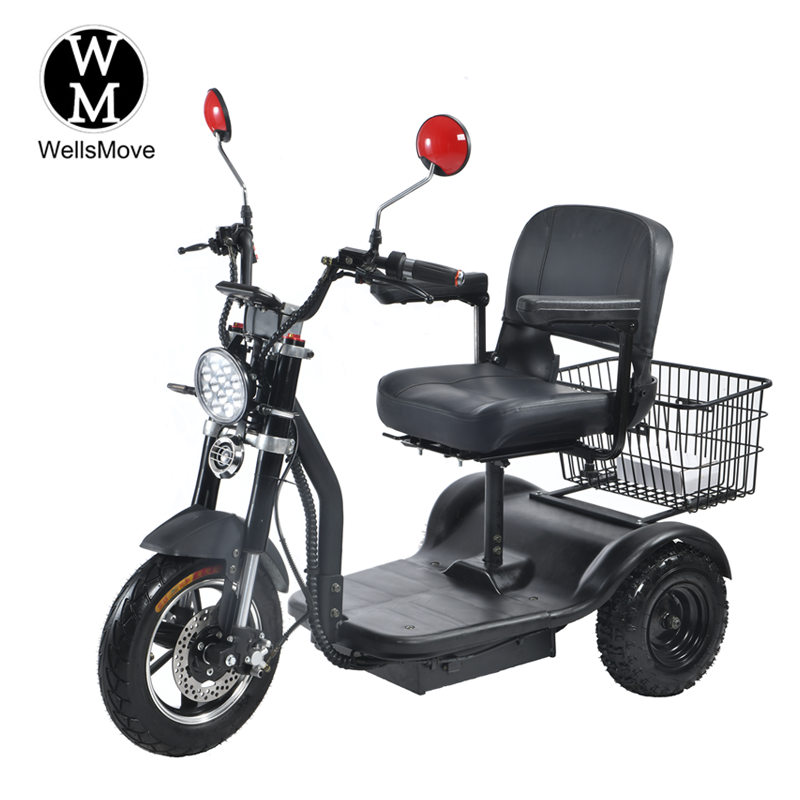Sales Opportunities for Three-Wheeled Senior Mobility Scooters in the European Market
Amid the global aging trend, Europe undoubtedly holds one of the greatest potential markets for the “silver economy.” According to Eurostat, by 2024, the proportion of people aged 65 and over in Europe will exceed 20%, with aging rates exceeding 23% in core economies such as Germany, Italy, and France. As the elderly population’s demand for independent mobility continues to grow, three-wheeled mobility scooters are becoming a “new necessity” in the European market due to their safety, convenience, and comfort. This article will comprehensively analyze the sales opportunities for three-wheeled mobility scooters in the European market from five perspectives: market background, demand pain points, policy benefits, product advantages, and competitive strategies, providing practical reference for foreign trade practitioners.
1. Europe’s Aging Population: Driving Demand for Mobility Scooters in the Hundreds of Billions of Yuan
Europe’s aging population is reflected not only in population proportions but also in the “active living” philosophy of the elderly. Contrary to conventional wisdom, modern European seniors prioritize independent mobility. They frequently shop, participate in community activities, take short trips, and some even maintain part-time jobs. However, declining physical function (such as joint pain and decreased balance) and the limitations of public transportation (such as peak-hour crowding and long distances between stations) make mobility a core pain point for many seniors.
1. Core Demand Scenarios Highlighted
Daily Short-Distance Transportation: European cities often retain narrow medieval streets, and walking is the primary mode of transportation. However, seniors typically walk no more than 500 meters. Three-wheeled mobility scooters can extend their travel radius to 3-5 kilometers, covering high-frequency destinations like supermarkets, pharmacies, and parks.
Outdoor Leisure Needs: Europe boasts abundant natural landscapes and walking trails, and seniors enjoy outdoor walks and picnics. Three-wheeled mobility scooters with storage and comfortable seating can meet their needs for resting while walking. Assisted Rehabilitation Demand: Some elderly people need to reduce weight bearing on their lower limbs due to postoperative rehabilitation or chronic conditions (such as arthritis). The armrest support and shock-absorbing design of three-wheeled mobility scooters can replace traditional crutches and reduce the risk of falls.
2. Market Size Continues to Expand
According to a report by the European Rehabilitation Equipment Federation (ERF), the European mobility scooter market will reach €8.7 billion in 2023, of which three-wheeled models will account for approximately 45%, with an annual growth rate of 12%-15%. Germany, the United Kingdom, and Spain are the core consumer countries, accounting for 28%, 19%, and 14% of the market share, respectively. Notably, the post-pandemic concept of “home-based care” has become more prevalent, and more families are proactively purchasing mobility devices for their elderly, driving market demand from “medical” scenarios to “everyday” scenarios.
2. Policy Dividends: A “Green Channel” for Access to the European Market
For foreign trade companies, the appeal of the European market lies not only in its vast demand but also in its comprehensive policy support and standard system. The EU and national governments are lowering the barrier to entry for consumers through subsidies and regulatory adjustments, while also providing fast-track entry for qualified products.
1. Widespread Consumer Subsidies
At the EU level: The EU’s Active Aging Initiative includes mobility scooters in the list of “assistive living devices.” Qualified products can enjoy purchase subsidies of up to 30%, and some member states can also offer VAT exemptions (for example, Germany’s VAT rate has been reduced from 19% to 7%).
National Policies: Germany’s Old Age Security Act stipulates that seniors aged 65 and over can apply for a subsidy of €500-1500 from local social security agencies for the purchase of a three-wheeled mobility scooter with a medical certificate. The UK covers mobility scooter costs through the Disability Living Allowance (DLA), without requiring an asset test. France has even introduced a “trade-in” program, offering a 15%-20% discount on older mobility scooters.
2. Clear Standard System, Manageable Compliance Costs
The EU has established strict technical standards (EN 12184) for mobility scooters, covering safety features (such as braking systems and load capacity), environmental requirements (such as battery life and noise reduction), and design specifications (such as armrest height and seat comfort). While compliance testing requires a certain amount of investment, once certified (such as CE and TÜV certification), the product can be freely circulated within the 27 EU member states without the need for repeated testing. Furthermore, European consumers have a high degree of trust in “compliance certification,” and certification marks have become a core competitive advantage in product sales.
3. The Core Advantage of Three-Wheeled Mobility Scooters: Targeting the Pain Points of the European Market
Compared to competing two-wheeled electric vehicles and four-wheeled mobility scooters, three-wheeled mobility scooters offer advantages in the European market in terms of safety, flexibility, and adaptability. They perfectly meet the needs of the elderly and the mobility environment of European cities.
1. Safety: Reduce Risk and Alleviate Consumer Concerns
Stable Structure: The three-wheel design (two wheels in front and one in the back, or one in front and two in the back) is more stable than two-wheeled vehicles and less prone to rollover, making it particularly suitable for the uneven roads of old European cities. Some high-end models also feature anti-roll bars and automatic braking systems that automatically lock the wheels on steep slopes (such as in Italian hill towns).
Low-Speed Design: EU regulations require that senior mobility scooters have a maximum speed of no more than 6 km/h, close to walking speed. This meets short-distance travel needs while avoiding the safety hazards of high-speed driving. Furthermore, the vehicles are equipped with audible and visual warning devices to alert pedestrians in crowded areas (such as markets and squares).
2. Flexibility: Adaptable to European Urban Spaces
Compact Size: Most three-wheeled mobility scooters fold down to a size of 0.8m × 0.5m × 0.4m, easily fitting into car trunks or elevators, addressing parking and storage challenges faced by European families. Some models also utilize lightweight materials (such as aluminum alloy), keeping weights under 15-20kg, making them easy for elderly individuals to carry.
Road Access Advantage: In Europe, three-wheeled mobility scooters are classified as “pedestrian aids” and can be used on sidewalks and pedestrian streets. They do not require a driver’s license, license plates, or insurance, making them much easier to use than four-wheeled mobility scooters (which require a driver’s license and license plates).
3. Adaptability: Meeting Diverse Needs
Battery Life and Charging: Given the short, frequent travel habits of European seniors, three-wheeled mobility scooters are typically designed with a battery life of 15-25 kilometers, sufficient for 2-3 days of use. They also support home 220V charging, fully charging in 8-10 hours, eliminating the need for dedicated charging stations.
User-Friendly Design: European consumers are highly demanding on product details, so models with the following features are particularly popular: adjustable armrests (to accommodate different heights), removable storage baskets (for convenient shopping), waterproof seats (for rainy weather), and USB charging ports (to power mobile phones).
Post time: Sep-17-2025



